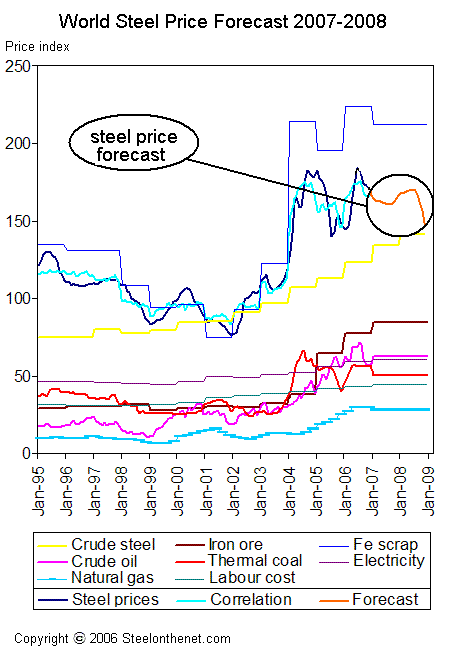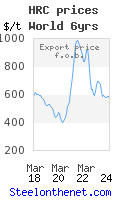Steel price forecast 2007-2008
As we reach the end of 2006, the consultants at www.steelonthenet.com thought it might be of interest to share our thoughts about world steel price evolution in 2007 and beyond.
The chart below summarises our thoughts. It shows historic world steel prices [indexed to Jan 2000 = 100] and the cost of most steelmaking input costs for the last twelve years, plus our price forecasts (circled).

The forecast is based on a mathematic analysis of the relationship between historic steel prices and each of the steelmaking cost inputs shown. Perhaps surprisingly, this analysis identifies only a weak (and insignificant) statistical relationship between steel prices and iron ore costs. A much stronger (and statistically significant) correlation proves evident between steel prices and (i) ferrous scrap and (ii) energy prices in the form of thermal coal, crude oil, and natural gas.
It may well be that scrap prices follow rather than lead steel prices, but industry experts see 2007 scrap prices either as largely unchanged from 2006 levels, or as falling.
Also, unlike iron ore (subject in recent days to a 9.5% price increase for 2007) most energy prices are forecast to fall in 2007. This applies especially to coal, where some experts predict 2007 price reductions of ~8 per cent, driven largely by improving infrastructure in Australia and higher output in Indonesia.
If we assume continued price cyclicality and recognise that the last peak of the price cycle was in mid-2006, this points us to the next pricing trough being around Q4 2007 and the next pricing peak being in Q3 2008.
Higher 2007 iron ore prices do not therefore mean higher 2007 steel prices. If historical fact is taken as a guide, falling energy prices and the inevitable down-swing of the 'normal' steel price cycle indicate falling steel prices and thus lower revenue streams for steelmakers in 2007.
For more information, contact economists@steelonthenet.com
The chart below summarises our thoughts. It shows historic world steel prices [indexed to Jan 2000 = 100] and the cost of most steelmaking input costs for the last twelve years, plus our price forecasts (circled).

The forecast is based on a mathematic analysis of the relationship between historic steel prices and each of the steelmaking cost inputs shown. Perhaps surprisingly, this analysis identifies only a weak (and insignificant) statistical relationship between steel prices and iron ore costs. A much stronger (and statistically significant) correlation proves evident between steel prices and (i) ferrous scrap and (ii) energy prices in the form of thermal coal, crude oil, and natural gas.
It may well be that scrap prices follow rather than lead steel prices, but industry experts see 2007 scrap prices either as largely unchanged from 2006 levels, or as falling.
Also, unlike iron ore (subject in recent days to a 9.5% price increase for 2007) most energy prices are forecast to fall in 2007. This applies especially to coal, where some experts predict 2007 price reductions of ~8 per cent, driven largely by improving infrastructure in Australia and higher output in Indonesia.
If we assume continued price cyclicality and recognise that the last peak of the price cycle was in mid-2006, this points us to the next pricing trough being around Q4 2007 and the next pricing peak being in Q3 2008.
Higher 2007 iron ore prices do not therefore mean higher 2007 steel prices. If historical fact is taken as a guide, falling energy prices and the inevitable down-swing of the 'normal' steel price cycle indicate falling steel prices and thus lower revenue streams for steelmakers in 2007.
For more information, contact economists@steelonthenet.com



